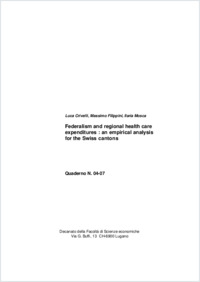Federalism and regional health care expenditures : an empirical analysis for the Swiss cantons
- Crivelli, Luca Istituto microeconomia e economia pubblica (MecoP), Facoltà di scienze economiche, Università della Svizzera italiana, Svizzera
- Filippini, Massimo Istituto microeconomia e economia pubblica (MecoP), Facoltà di scienze economiche, Università della Svizzera italiana, Svizzera
- Mosca, Ilaria Istituto microeconomia e economia pubblica (MecoP), Facoltà di scienze economiche, Università della Svizzera italiana, Svizzera
-
2004
29 p
English
Switzerland (7.2 million inhabitants) is a federal state composed of 26 cantons. Article 3 of the Federal Constitution grants ample autonomy to individual cantons in those sectors that are not directly regulated by the Constitution, among others health and social care. The autonomy of cantons creates strong heterogeneity in terms of regulatory systems and the organization of health care services. Moreover, the State’s financial contribution varies in size and form according to the 26 different legal frameworks. Instead of having one single health system, Switzerland can be seen as 26 microsystems linked to each other by the Federal Health Insurance Act (FHIA), which came into force on January 1st, 1996. The present-day differences between cantons make Switzerland a natural laboratory where to develop some interesting economic analyses and observations that might be useful for countries set on reorganizing their health systems in a federal way. In the first part of the paper we present an overview of Switzerland’s health care system, focussing in particular on the role of federalism and on the differences between compulsory health insurance premiums and per-capita health expenses in the cantons. The second part of the paper presents an econometric analysis, using panel data over the period 1996-2001, of the most important determinants in the cantonal health care expenditures. Following the approach of Gerdtham and Jönsson (2000) for international health comparisons, we consider demographic, socio-economic, and production capacity factors as explanatory variables of the model.
- Language
-
- English
- Classification
- Economics
- License
-
License undefined
- Open access status
- green
- Identifiers
-
- RERO DOC 5198
- ARK ark:/12658/srd1318071
- Persistent URL
- https://n2t.net/ark:/12658/srd1318071
Statistics
Document views: 171
File downloads:
- Texte intégral: 370
